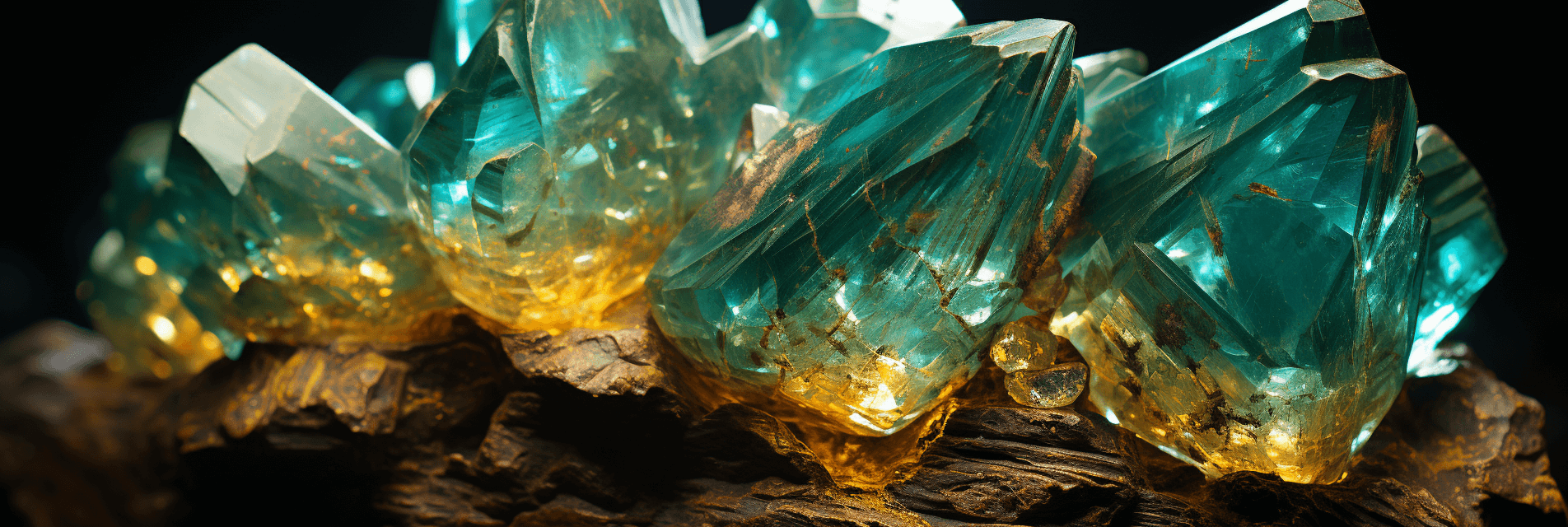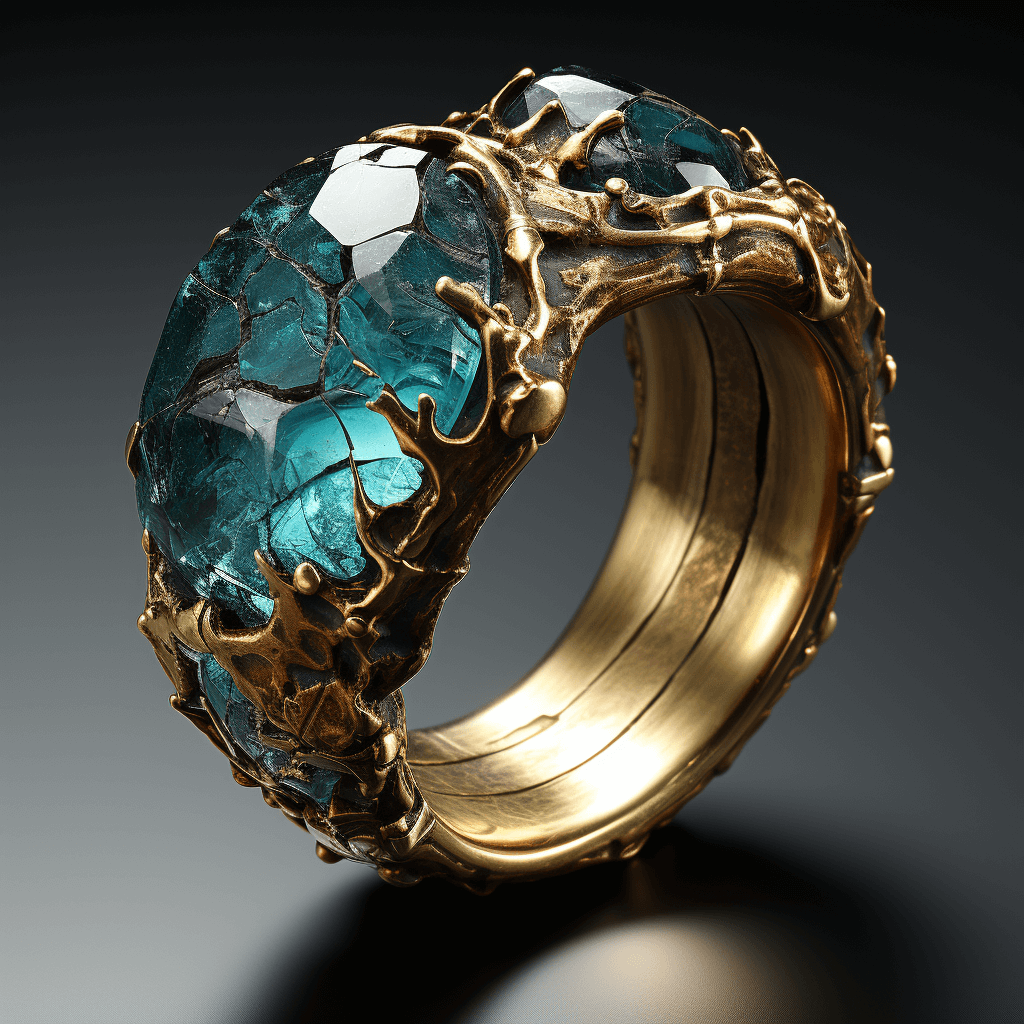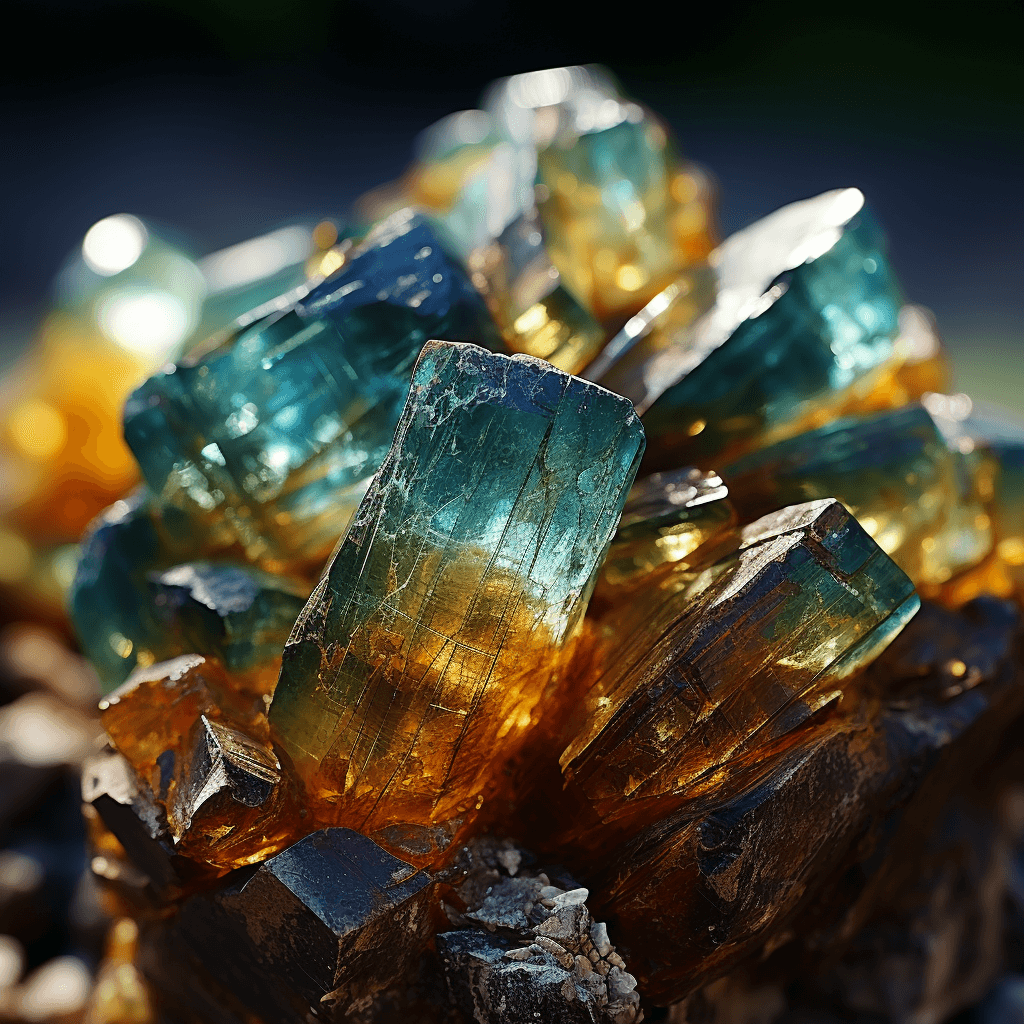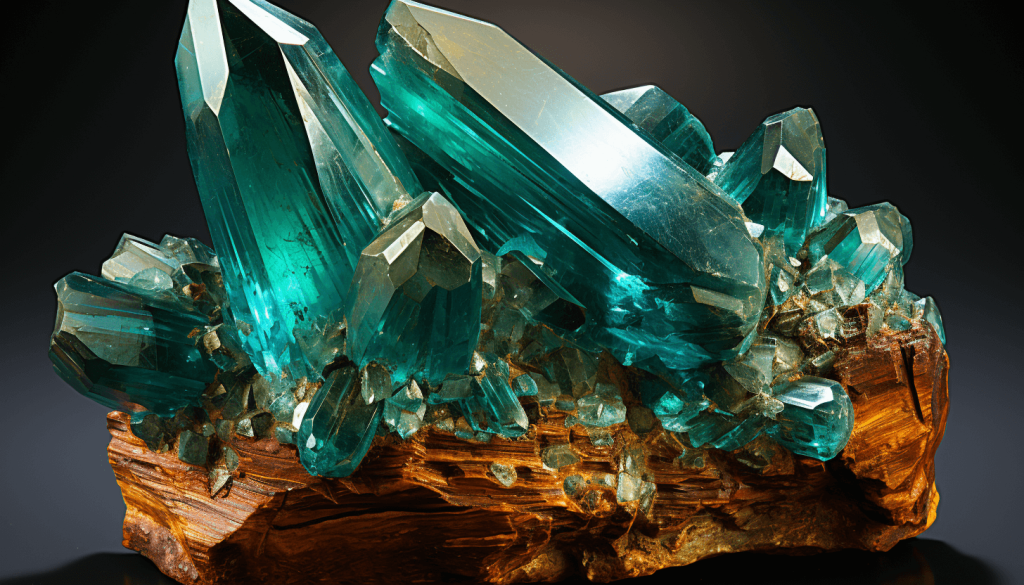Apatite, often mistaken for other minerals, is a unique gemstone with vibrant colors and properties. Not to be confused with the mineral “agate,” Apatite stands out for its distinct characteristics and role in the gemological and geological worlds.
Introduction to Apatite: Unveiling the Gem of Clarity and Motivation
Originating from the Greek word apate, which means “deceit,” Apatite was named for its deceptive nature, often being mistaken for other precious stones. However, beyond its initial deceptive appearance, Apatite reveals a world of clarity, motivation, and spiritual depth. Found in a spectrum of colors, from deep blues reminiscent of the sea to greens that echo the hues of the forest, Apatite has captivated the hearts of gem enthusiasts and spiritual seekers alike.
While it might not be as renowned as diamonds or rubies in the jewelry market, Apatite holds its charm. Its vibrant colors and metaphysical properties make it a sought-after stone for those looking to enhance their clarity of thought and inner vision. Moreover, its role in geological studies, particularly in understanding phosphorus cycles in the environment, showcases its importance beyond just aesthetics.
As we delve deeper into the world of Apatite, we’ll uncover its formation, various types, historical significance, and modern-day applications. Whether you’re a gem lover, a spiritual seeker, or just curious about this unique stone, there’s much to discover about Apatite.
Geological Formation of Apatite: The Science Behind the Stone
Apatite’s formation is a fascinating journey that takes us deep into the Earth’s crust. This mineral, primarily composed of phosphate groups, calcium, and other elements, forms under various geological conditions. From igneous to sedimentary environments, Apatite’s presence is a testament to its adaptability and diverse formation processes.
| Property | Description |
|---|---|
| Chemical Formula | Ca5(PO4)3(F,Cl,OH) |
| Color | Typically green, but can also be blue, brown, violet, yellow, or colorless |
| Crystal System | Hexagonal |
| Hardness (Mohs scale) | 5 |
| Luster | Vitreous to subresinous |
| Transparency | Transparent to translucent |
| Refractive Index | 1.634 to 1.638 |
| Specific Gravity | 3.16 to 3.22 |
| Cleavage | Indistinct |
One of the most intriguing aspects of Apatite is its ability to form in various rock types. In igneous rocks, it’s commonly found in granites and syenites. In sedimentary environments, Apatite can form from the remains of marine organisms with high phosphorus concentrations. Additionally, in metamorphic rocks, Apatite can form under high heat and pressure conditions.
Frequently Asked Questions
Is Apatite common or rare?
While Apatite is relatively common in the Earth’s crust, gem-quality apatite suitable for jewelry is rarer. The mineral is widely distributed in rocks and is essential for their phosphorus content. Still, only a fraction of apatite deposits are of high enough quality to be considered gem-grade.
Understanding Apatite’s geological formation and properties not only gives us insights into the stone’s physical characteristics but also deepens our appreciation for the intricate processes that give rise to such beauty.
Colors and Varieties of Apatite: A Spectrum of Beauty
Apatite’s allure lies in its metaphysical properties and its stunning array of colors. From the serene blues reminiscent of tropical oceans to the vibrant greens echoing lush forests, Apatite offers a color palette that captivates gem enthusiasts and jewelry designers alike.
| Color | Description |
|---|---|
| Blue | Often compared to the hues of a tropical ocean, blue Apatite is among the most sought-after varieties. It is believed to have a calming effect and is associated with communication and self-expression. |
| Green | With its vibrant shades,Green Apatite is reminiscent of a lush forest. It is often linked to nature, growth, and renewal. |
| Yellow | Yellow Apatite, sometimes called “gold apatite,” is associated with clarity of thought and mental stimulation. |
| Violet | A rarer variety, violet Apatite is often linked to spiritual insight and is believed to aid meditation and intuition. |
| Colorless | While not as popular as its colorful counterparts, colorless Apatite is valued for its clarity and is often used in intricate jewelry designs. |
| Brown | Though less common in jewelry,Brown apatite is appreciated for its earthy tones and is often used in beadwork and carvings. |
Each color of Apatite, with its unique shade and intensity, carries its own set of energies and properties. Whether you’re drawn to the deep blues or the vibrant greens, there’s an Apatite for every preference and purpose.
Frequently Asked Questions
What is unique about Apatite?
Apatite is unique for several reasons. Its wide range of colors, from blues to greens and beyond, makes it versatile for jewelry. Moreover, it’s one of the few minerals produced and used by biological micro-environmental systems, making it significant in the study of biomineralization. Additionally, its name, derived from the Greek word for “deceit,” reflects its history of being mistaken for other minerals.
Whether you’re choosing Apatite for its aesthetic appeal, its metaphysical properties, or both, understanding its varieties enriches the experience of owning and wearing this captivating gem.
Historical Significance of Apatite: Ancient Uses and Cultural References

The history of Apatite is as vibrant as its colors. This gemstone, often mistaken for other precious stones due to its diverse palette, has been a part of human culture for centuries. Its name, derived from the Greek word ‘apatao,’ meaning ‘to deceive,’ is a testament to its history of being frequently misidentified.
“In the tapestry of history, apatite threads its way through various cultures, each attributing its significance and value to the stone.”
In ancient Egypt, Apatite was used in amulets and as a part of burial items, believed to aid the journey to the afterlife. The vibrant blue variety of Apatite was especially prized, often mistaken for turquoise or lapis lazuli, and was used in intricate jewelry designs worn by the nobility.
The indigenous tribes of Brazil, where some of the world’s finest Apatite is sourced, considered the stone a spiritual aid. They believed that it could connect the living world with the ancestral spirits, and it was often used in rituals and ceremonies.
In Europe, during the Renaissance, Apatite was ground into powder and used as a pigment for paintings, giving some artworks their distinctive blue-green hue. This use, though less common now, showcased the stone’s versatility beyond jewelry and adornment.
Today, while Apatite’s historical uses in art and culture are celebrated, it’s also recognized for its metaphysical properties, making it a gemstone that bridges the past with the present.
From ancient tombs to modern jewelry shops, Apatite’s journey through history is a testament to its enduring appeal and significance. As we continue to unearth its stories, the stone’s multifaceted nature becomes more enchanting.
Metaphysical Properties of Apatite: Spiritual Insights and Chakra Connections
Apatite, beyond its physical allure, is a stone deeply connected to the spiritual realm. Its metaphysical properties are believed to offer a bridge between consciousness and matter, making it a sought-after gem for those on a spiritual journey.
The stone is often associated with clarity in thought and communication. For those seeking to deepen their meditation practices or enhance their intuitive abilities, Apatite can serve as a guiding stone, helping to clear mental fog and foster a space for insights to emerge.
“Apatite’s energy is said to be one of inspiration and motivation, helping its bearer to set and achieve goals with determination.”
One of the most profound connections of Apatite is with the throat chakra. This chakra, located at the base of the throat, is linked to communication, self-expression, and truth. Apatite’s resonance with the throat chakra can aid in enhancing communication skills, making it easier to express oneself and speak one’s truth with confidence.
Additionally, Apatite is linked to the third eye chakra, the center of intuition, foresight, and spiritual insight. When this chakra is in balance, it’s believed that one can see beyond the physical realm, tapping into higher states of consciousness and intuition.
Whether used in meditation, worn as jewelry, or kept as a talisman, Apatite’s metaphysical properties can offer support and guidance in various aspects of life, from personal growth to spiritual exploration.
Frequently Asked Questions
What energy does apatite have?
Apatite is believed to possess a dual energy. It’s uplifting and calming, promoting a balance between the physical and spiritual realms. This energy can help enhance motivation, encouraging openness and social ease and fostering a sense of clarity and focus.
How do you activate apatite stone?
To activate Apatite, it’s recommended to cleanse it first, either by smudging it with sage or placing it under moonlight. After cleansing, hold the stone in your hands, close your eyes, and set your intention for the stone. Visualize its energy aligning with yours, and it’s now ready to use.
Apatite and the Zodiac: Astrological Affinities and Birthstone Significance

Apatite, with its diverse range of colors and energies, has a unique connection to the zodiac. While not traditionally listed as a birthstone for any specific month, its metaphysical properties resonate deeply with certain astrological signs.
Gemini, the sign of the twins, often seeks balance and harmony in their lives. The clarity and communication-enhancing properties of Apatite can be particularly beneficial for Geminis, aiding them in expressing their dual nature with grace and understanding.
Similarly, Libra, another air sign, is drawn to the balancing energies of Apatite. Librans often seek equilibrium in all things, and Apatite can serve as a grounding force, helping them find the middle ground they so often desire.
Aries, a fire sign known for its leadership and pioneering spirit, can also benefit from Apatite’s motivational energies. The stone can help Arians channel their natural enthusiasm and drive in a focused and productive manner.
While Apatite is not traditionally recognized as a birthstone for any specific month, many modern crystal enthusiasts and astrologers recommend it as a personal stone for those born under the signs of Gemini, Libra, and Aries. Its unique vibrational frequency aligns well with the energies of these signs, offering support, balance, and clarity.
Regardless of one’s zodiac sign, the energies of Apatite can be harnessed by anyone seeking clarity, motivation, and enhanced communication. However, its connection to the stars offers an added layer of resonance for those whose astrological signs align with the stone’s energies.
Apatite in Modern Healing Practices: From Meditation to Energy Work
In today’s fast-paced world, many individuals turn to ancient stones and crystals like Apatite to find balance, clarity, and healing. With its vibrant energies, Apatite has found its way into various modern healing practices.
“Apatite is more than just a beautiful stone; it’s a bridge between clarity and action, helping one to align intention with manifestation.”
One of the primary uses of Apatite in contemporary healing is in meditation. Practitioners often place Apatite on their throat chakra or third eye during meditation sessions. This is believed to enhance clarity of thought, improve communication with the higher self, and foster a deeper connection to spiritual guides.
Energy workers and Reiki practitioners also utilize Apatite in their sessions. The stone is said to help balance the energetic body, clear away confusion and amplify healing intentions. Its calming energies can also assist in reducing stress and emotional turmoil, making it a favorite for those undergoing transformative life changes.
“In the hands of a skilled healer, apatite becomes a tool of profound transformation, guiding the soul towards its highest truth and potential.”
Whether used in a structured healing session or worn as jewelry, Apatite’s energies offer support, guidance, and a touch of magic to all who come into contact with it.
Caring for Your Apatite: Maintenance and Preservation Tips

Apatite, like all gemstones, requires proper care to maintain its beauty and integrity. While it’s a relatively durable stone, there are certain things you should avoid to ensure its longevity.
What NOT to do:
- Avoid Harsh Chemicals: Never clean apatite with harsh chemicals or cleaning agents. These can damage the stone’s surface and diminish its luster.
- Keep Away from Extreme Heat: Sudden temperature changes or prolonged exposure to heat can cause fractures in the stone.
- Don’t Wear During Strenuous Activities: Physical activities like sports or heavy lifting can lead to accidental knocks, potentially chipping the stone.
- Avoid Ultrasonic Cleaners: These can cause internal fractures in the apatite.
For daily care, wipe your apatite jewelry with a soft, damp cloth to remove dirt or oils. If a deeper clean is needed, use mild, soapy water and a soft brush, then rinse thoroughly and pat dry with a soft cloth.
Frequently Asked Questions
Can I shower with Apatite?
It’s best to avoid showering with apatite jewelry. The chemicals in shampoos and soaps and the temperature changes can affect the stone’s appearance and integrity.
Can you sleep with apatite crystal?
While sleeping with Apatite can enhance its metaphysical benefits, ensuring the stone is secure, especially if set in jewelry, to prevent any damage or loss during sleep is essential.
Apatite’s Role in the Gem Market: Rarity, Demand, and Value
Apatite, though less renowned than diamonds or sapphires, has carved a niche in the gem market. Its unique colors and properties make it a sought-after stone for collectors and jewelry enthusiasts.
The value of Apatite largely depends on its color, clarity, and origin. The more intense the color, especially in the case of the coveted neon blue-green variety, the higher the value. Clarity also plays a significant role; transparent stones with minimal inclusions fetch a higher price than those with visible flaws.
While apatite deposits are found in various parts of the world, including Brazil, Mexico, Myanmar, and Africa, the most prized stones come from Madagascar. These are known for their vibrant colors and exceptional clarity.
Over the years, the demand for Apatite has steadily increased, especially among those who appreciate its metaphysical properties. However, it’s essential to be cautious and well-informed when purchasing Apatite, as its growing popularity has also led to the emergence of synthetic or treated stones in the market.
Apatite is often mistaken for other gemstones due to its wide range of colors. Its name is derived from the Greek word “apate,” which means “deceit,” reflecting its ability to mimic other gems.
Distinguishing Genuine Apatite: Avoiding Fakes and Imitations
In the world of gemstones, the allure of Apatite’s vibrant hues and metaphysical properties can sometimes lead to deception. Imitations and synthetically produced stones are becoming more common, making it crucial for enthusiasts and buyers to distinguish genuine Apatite from fakes.
“The beauty of a gemstone lies not just in its appearance, but in its authenticity.”
Color Test: Genuine apatite has a distinct range of colors. While it’s available in various shades, the color should be consistent throughout the stone. Fakes often have uneven color distribution or overly saturated hues that don’t resemble natural Apatite.
Hardness Test: Apatite is relatively soft, with a Mohs hardness of 5. Synthetic stones or imitations might be harder or softer. A simple scratch test against a known material can give clues about its authenticity.
Refractive Index: Genuine apatite has a specific refractive index. If you have access to a refractometer, this can be a definitive method to verify the stone’s authenticity.
Price: If the deal seems too good to be true, it probably is. Extremely cheap Apatite might be a red flag for imitation or low-quality stones.
Consult a Gemologist: When in doubt, it’s always best to consult with a certified gemologist. They have the tools and expertise to confirm the authenticity of a gemstone.
Remember, knowledge is power. The more informed you are about the characteristics of genuine Apatite, the better equipped you’ll be to make a wise purchase.
Apatite in Industry: Beyond Jewelry and Healing

Apatite, while renowned for its beauty and metaphysical properties, also plays a significant role in various industries. Its unique chemical composition and properties make it a valuable resource in several applications beyond jewelry and spiritual healing.
Phosphate Mining: Apatite is a primary source of phosphate, which is extensively used in the production of fertilizers. The global demand for food production has increased the need for phosphates, making Apatite mining a crucial industry.
Animal Feed: The phosphorus derived from Apatite is also used as a dietary supplement in animal feed. It aids in forming bones and teeth and is vital for energy transfer and buffering in animals.
Chemical Industry: Apatite is used in the production of various chemicals, including hydrofluoric acid. This acid is essential in the manufacture of fluorine-containing compounds and aluminum production.
Water Treatment: Due to its ability to adsorb specific contaminants, Apatite has been researched for its potential use in water treatment processes, especially in removing radionuclides and heavy metals from water.
Biomedical Applications: Hydroxyapatite, a type of Apatite, is used in bone grafting and dental applications due to its similarity to the mineral component of bones and teeth. It promotes bone growth and is used in various orthopedic and dental procedures.
From agriculture to medicine, the versatility of Apatite is evident. Its significance in various industries underscores that this gemstone is not just a piece of beauty but also a material of immense practical value.
FAQs About Apatite: Addressing Common Questions and Misconceptions
What is apatite crystal good for?
Apatite is renowned for its metaphysical properties, promoting clarity, motivation, and personal growth. It’s also believed to encourage openness and social ease, making it great for interpersonal interactions.
Is Apatite a valuable stone?
While Apatite is not as valuable as gemstones like diamonds or sapphires, its unique colors and properties make it a sought-after stone in the gem market, especially for collectors and those interested in its metaphysical properties.
Is Apatite good for love?
Apatite is believed to clear confusion, apathy, or negativity, making way for love and passion. It’s also thought to enhance communication and promote a deeper connection between partners.
Where should I put Apatite?
For those who believe in its energy-enhancing properties, placing Apatite in the home or workspace can promote a positive environment. It’s also commonly worn as jewelry, especially as necklaces, to keep its energies close to the throat chakra.
Is apatite good for manifesting?
Yes, Apatite is often used in manifestation practices. Its energies are believed to clear away negativity and enhance motivation, making achieving goals easier and bringing intentions to fruition.
What energy does apatite have?
Apatite is often associated with clarity, motivation, and spiritual guidance. It’s believed to have a cleansing energy that clears away confusion and negativity, making way for positive growth.
How do you activate Apatite?
To activate Apatite, many practitioners recommend cleansing the stone first by smudging, using sound, or placing it under moonlight. After cleansing, holding the stone and setting a specific intention can “activate” its energies for that purpose.
Who can wear Apatite stone?
Anyone can wear Apatite. It’s especially beneficial for those seeking clarity, motivation, or enhanced communication abilities. Additionally, those born under the Gemini zodiac sign might find it particularly resonating.
What pairs with Apatite?
In jewelry and energy work, apatite pairs well with stones that enhance communication and clarity, such as lapis lazuli or aquamarine. It can also be combined with grounding stones like smoky quartz to balance its high vibrational energy.
What chakra is Apatite for?
Apatite is primarily associated with the throat chakra, enhancing communication and self-expression. However, its deep blue variety can also resonate with the third eye chakra, promoting intuition and spiritual insight.
How strong is apatite?
On the Mohs scale of mineral hardness, Apatite is rated at 5, which means it’s of medium hardness. While it’s not as soft as talc or as hard as diamond, care should still be taken to prevent scratches or damage.
How do you recharge blue Apatite?
Like other crystals,Blue Apatite can be recharged by placing it under the moonlight, especially during a full moon. Some also believe in recharging it by placing it on a bed of quartz crystals or exposing it to sounds like bells or singing bowls.
Is Apatite found in specific regions?
While Apatite can be found in various parts of the world, significant deposits are located in Brazil, Myanmar, India, Kenya, Madagascar, Mexico, Norway, Sri Lanka, South Africa, Spain, Canada, and the United States.

